Analysis of Business Structures and External Environment Report
VerifiedAdded on 2023/01/09
|11
|3063
|83
Report
AI Summary
This report provides a comprehensive overview of various business structures, including micro, small, medium, and large businesses, as well as sole proprietorships, partnerships, and corporations. It defines the characteristics of each structure and provides relevant examples. The report also delves into organizational structures such as divisional, flat, and hierarchical structures, using Tesco as a case study. Furthermore, it highlights the importance of external analysis, specifically utilizing PESTLE analysis to understand the political, economic, social, technological, legal, and environmental factors impacting businesses. The report emphasizes how these factors influence a company's performance, customers, and suppliers, providing valuable insights for business development and strategic decision-making.
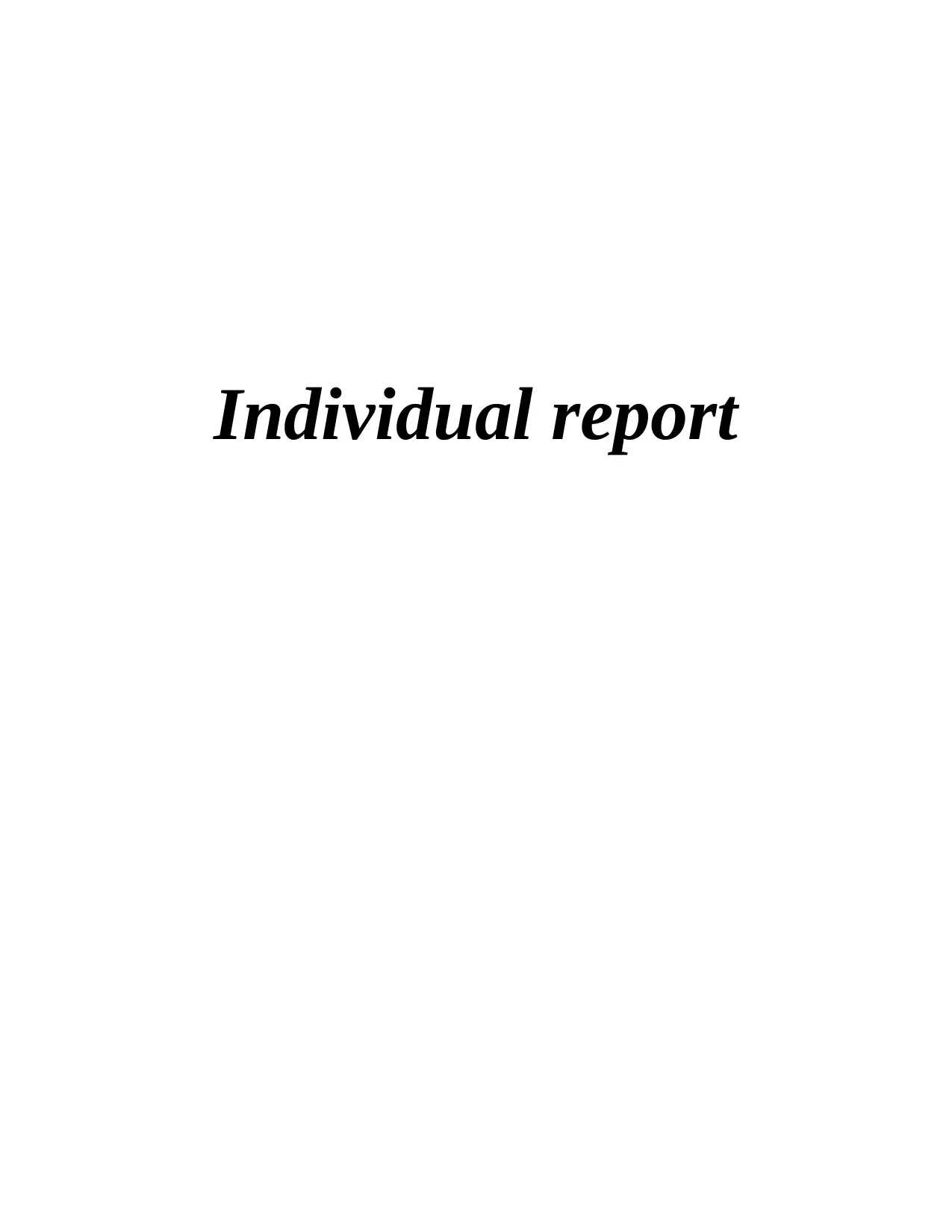
Individual report
Paraphrase This Document
Need a fresh take? Get an instant paraphrase of this document with our AI Paraphraser
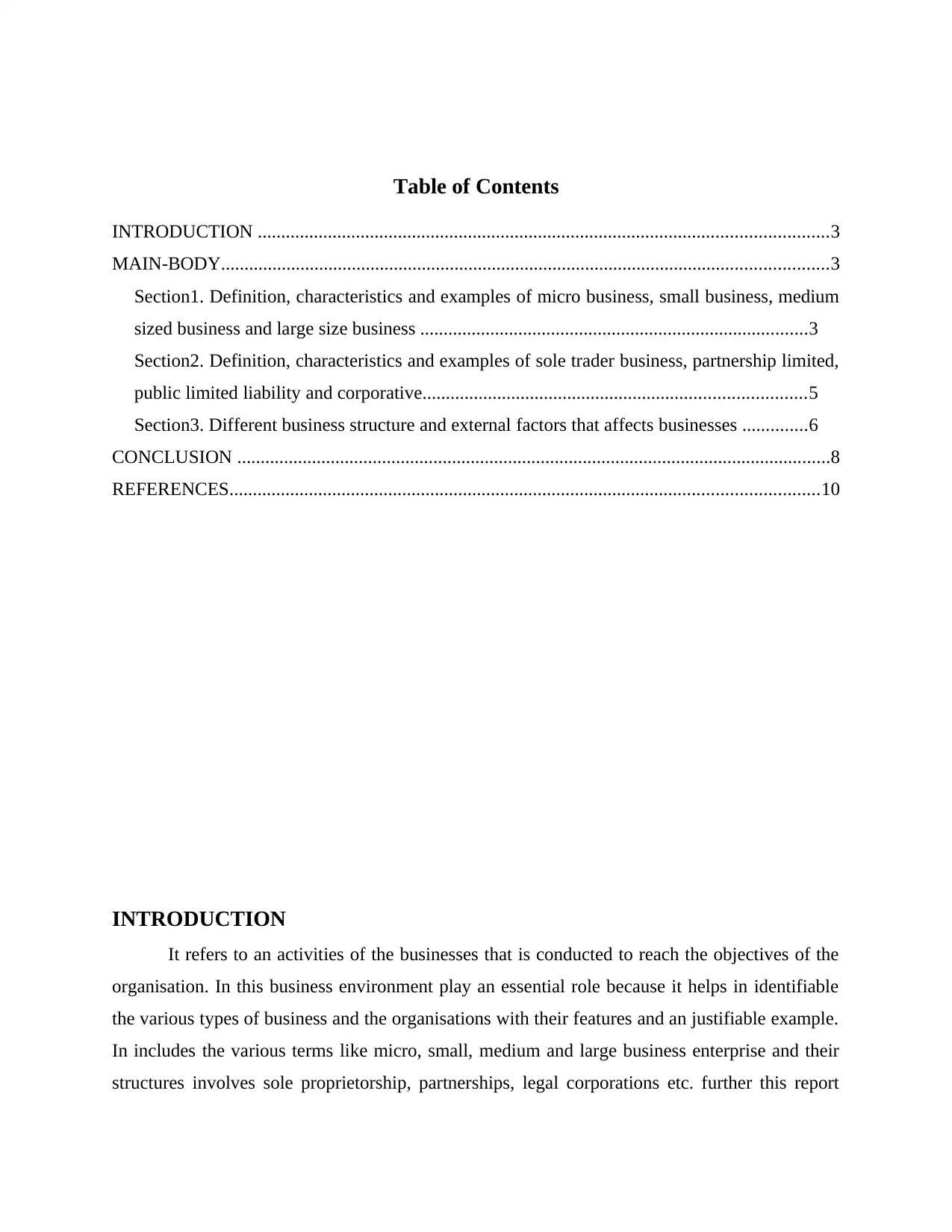
Table of Contents
INTRODUCTION ..........................................................................................................................3
MAIN-BODY..................................................................................................................................3
Section1. Definition, characteristics and examples of micro business, small business, medium
sized business and large size business ...................................................................................3
Section2. Definition, characteristics and examples of sole trader business, partnership limited,
public limited liability and corporative..................................................................................5
Section3. Different business structure and external factors that affects businesses ..............6
CONCLUSION ...............................................................................................................................8
REFERENCES..............................................................................................................................10
INTRODUCTION
It refers to an activities of the businesses that is conducted to reach the objectives of the
organisation. In this business environment play an essential role because it helps in identifiable
the various types of business and the organisations with their features and an justifiable example.
In includes the various terms like micro, small, medium and large business enterprise and their
structures involves sole proprietorship, partnerships, legal corporations etc. further this report
INTRODUCTION ..........................................................................................................................3
MAIN-BODY..................................................................................................................................3
Section1. Definition, characteristics and examples of micro business, small business, medium
sized business and large size business ...................................................................................3
Section2. Definition, characteristics and examples of sole trader business, partnership limited,
public limited liability and corporative..................................................................................5
Section3. Different business structure and external factors that affects businesses ..............6
CONCLUSION ...............................................................................................................................8
REFERENCES..............................................................................................................................10
INTRODUCTION
It refers to an activities of the businesses that is conducted to reach the objectives of the
organisation. In this business environment play an essential role because it helps in identifiable
the various types of business and the organisations with their features and an justifiable example.
In includes the various terms like micro, small, medium and large business enterprise and their
structures involves sole proprietorship, partnerships, legal corporations etc. further this report
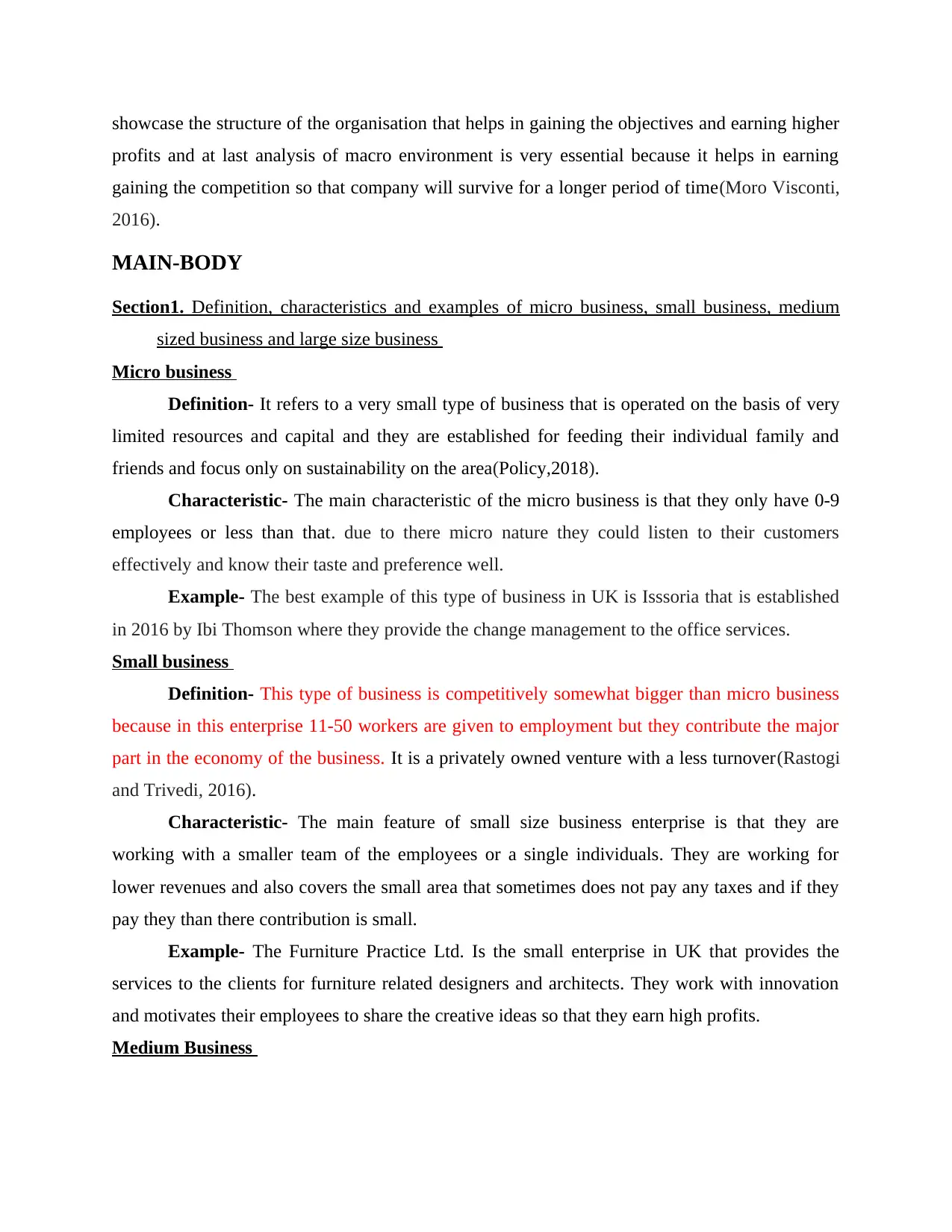
showcase the structure of the organisation that helps in gaining the objectives and earning higher
profits and at last analysis of macro environment is very essential because it helps in earning
gaining the competition so that company will survive for a longer period of time(Moro Visconti,
2016).
MAIN-BODY
Section1. Definition, characteristics and examples of micro business, small business, medium
sized business and large size business
Micro business
Definition- It refers to a very small type of business that is operated on the basis of very
limited resources and capital and they are established for feeding their individual family and
friends and focus only on sustainability on the area(Policy,2018).
Characteristic- The main characteristic of the micro business is that they only have 0-9
employees or less than that. due to there micro nature they could listen to their customers
effectively and know their taste and preference well.
Example- The best example of this type of business in UK is Isssoria that is established
in 2016 by Ibi Thomson where they provide the change management to the office services.
Small business
Definition- This type of business is competitively somewhat bigger than micro business
because in this enterprise 11-50 workers are given to employment but they contribute the major
part in the economy of the business. It is a privately owned venture with a less turnover(Rastogi
and Trivedi, 2016).
Characteristic- The main feature of small size business enterprise is that they are
working with a smaller team of the employees or a single individuals. They are working for
lower revenues and also covers the small area that sometimes does not pay any taxes and if they
pay they than there contribution is small.
Example- The Furniture Practice Ltd. Is the small enterprise in UK that provides the
services to the clients for furniture related designers and architects. They work with innovation
and motivates their employees to share the creative ideas so that they earn high profits.
Medium Business
profits and at last analysis of macro environment is very essential because it helps in earning
gaining the competition so that company will survive for a longer period of time(Moro Visconti,
2016).
MAIN-BODY
Section1. Definition, characteristics and examples of micro business, small business, medium
sized business and large size business
Micro business
Definition- It refers to a very small type of business that is operated on the basis of very
limited resources and capital and they are established for feeding their individual family and
friends and focus only on sustainability on the area(Policy,2018).
Characteristic- The main characteristic of the micro business is that they only have 0-9
employees or less than that. due to there micro nature they could listen to their customers
effectively and know their taste and preference well.
Example- The best example of this type of business in UK is Isssoria that is established
in 2016 by Ibi Thomson where they provide the change management to the office services.
Small business
Definition- This type of business is competitively somewhat bigger than micro business
because in this enterprise 11-50 workers are given to employment but they contribute the major
part in the economy of the business. It is a privately owned venture with a less turnover(Rastogi
and Trivedi, 2016).
Characteristic- The main feature of small size business enterprise is that they are
working with a smaller team of the employees or a single individuals. They are working for
lower revenues and also covers the small area that sometimes does not pay any taxes and if they
pay they than there contribution is small.
Example- The Furniture Practice Ltd. Is the small enterprise in UK that provides the
services to the clients for furniture related designers and architects. They work with innovation
and motivates their employees to share the creative ideas so that they earn high profits.
Medium Business
⊘ This is a preview!⊘
Do you want full access?
Subscribe today to unlock all pages.

Trusted by 1+ million students worldwide
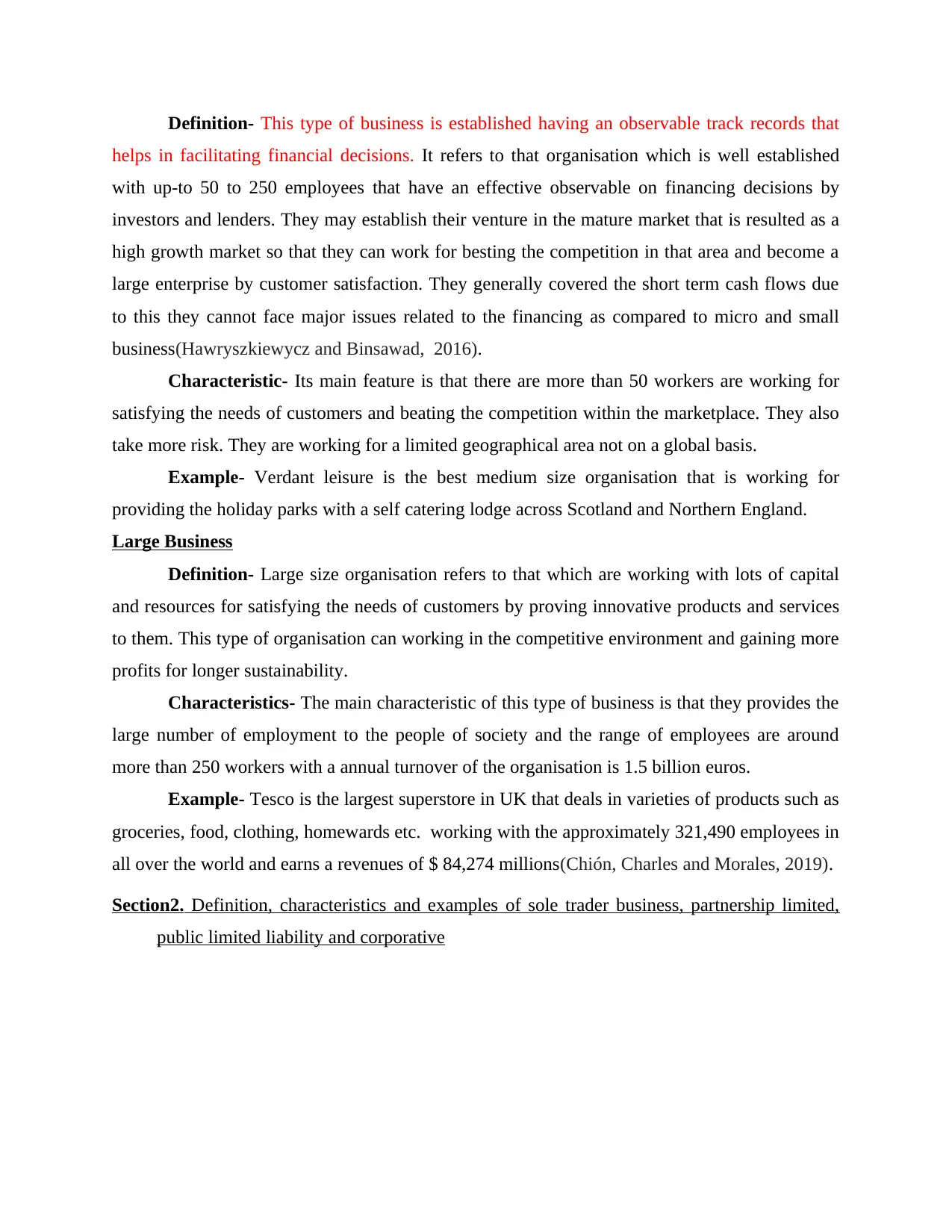
Definition- This type of business is established having an observable track records that
helps in facilitating financial decisions. It refers to that organisation which is well established
with up-to 50 to 250 employees that have an effective observable on financing decisions by
investors and lenders. They may establish their venture in the mature market that is resulted as a
high growth market so that they can work for besting the competition in that area and become a
large enterprise by customer satisfaction. They generally covered the short term cash flows due
to this they cannot face major issues related to the financing as compared to micro and small
business(Hawryszkiewycz and Binsawad, 2016).
Characteristic- Its main feature is that there are more than 50 workers are working for
satisfying the needs of customers and beating the competition within the marketplace. They also
take more risk. They are working for a limited geographical area not on a global basis.
Example- Verdant leisure is the best medium size organisation that is working for
providing the holiday parks with a self catering lodge across Scotland and Northern England.
Large Business
Definition- Large size organisation refers to that which are working with lots of capital
and resources for satisfying the needs of customers by proving innovative products and services
to them. This type of organisation can working in the competitive environment and gaining more
profits for longer sustainability.
Characteristics- The main characteristic of this type of business is that they provides the
large number of employment to the people of society and the range of employees are around
more than 250 workers with a annual turnover of the organisation is 1.5 billion euros.
Example- Tesco is the largest superstore in UK that deals in varieties of products such as
groceries, food, clothing, homewards etc. working with the approximately 321,490 employees in
all over the world and earns a revenues of $ 84,274 millions(Chión, Charles and Morales, 2019).
Section2. Definition, characteristics and examples of sole trader business, partnership limited,
public limited liability and corporative
helps in facilitating financial decisions. It refers to that organisation which is well established
with up-to 50 to 250 employees that have an effective observable on financing decisions by
investors and lenders. They may establish their venture in the mature market that is resulted as a
high growth market so that they can work for besting the competition in that area and become a
large enterprise by customer satisfaction. They generally covered the short term cash flows due
to this they cannot face major issues related to the financing as compared to micro and small
business(Hawryszkiewycz and Binsawad, 2016).
Characteristic- Its main feature is that there are more than 50 workers are working for
satisfying the needs of customers and beating the competition within the marketplace. They also
take more risk. They are working for a limited geographical area not on a global basis.
Example- Verdant leisure is the best medium size organisation that is working for
providing the holiday parks with a self catering lodge across Scotland and Northern England.
Large Business
Definition- Large size organisation refers to that which are working with lots of capital
and resources for satisfying the needs of customers by proving innovative products and services
to them. This type of organisation can working in the competitive environment and gaining more
profits for longer sustainability.
Characteristics- The main characteristic of this type of business is that they provides the
large number of employment to the people of society and the range of employees are around
more than 250 workers with a annual turnover of the organisation is 1.5 billion euros.
Example- Tesco is the largest superstore in UK that deals in varieties of products such as
groceries, food, clothing, homewards etc. working with the approximately 321,490 employees in
all over the world and earns a revenues of $ 84,274 millions(Chión, Charles and Morales, 2019).
Section2. Definition, characteristics and examples of sole trader business, partnership limited,
public limited liability and corporative
Paraphrase This Document
Need a fresh take? Get an instant paraphrase of this document with our AI Paraphraser
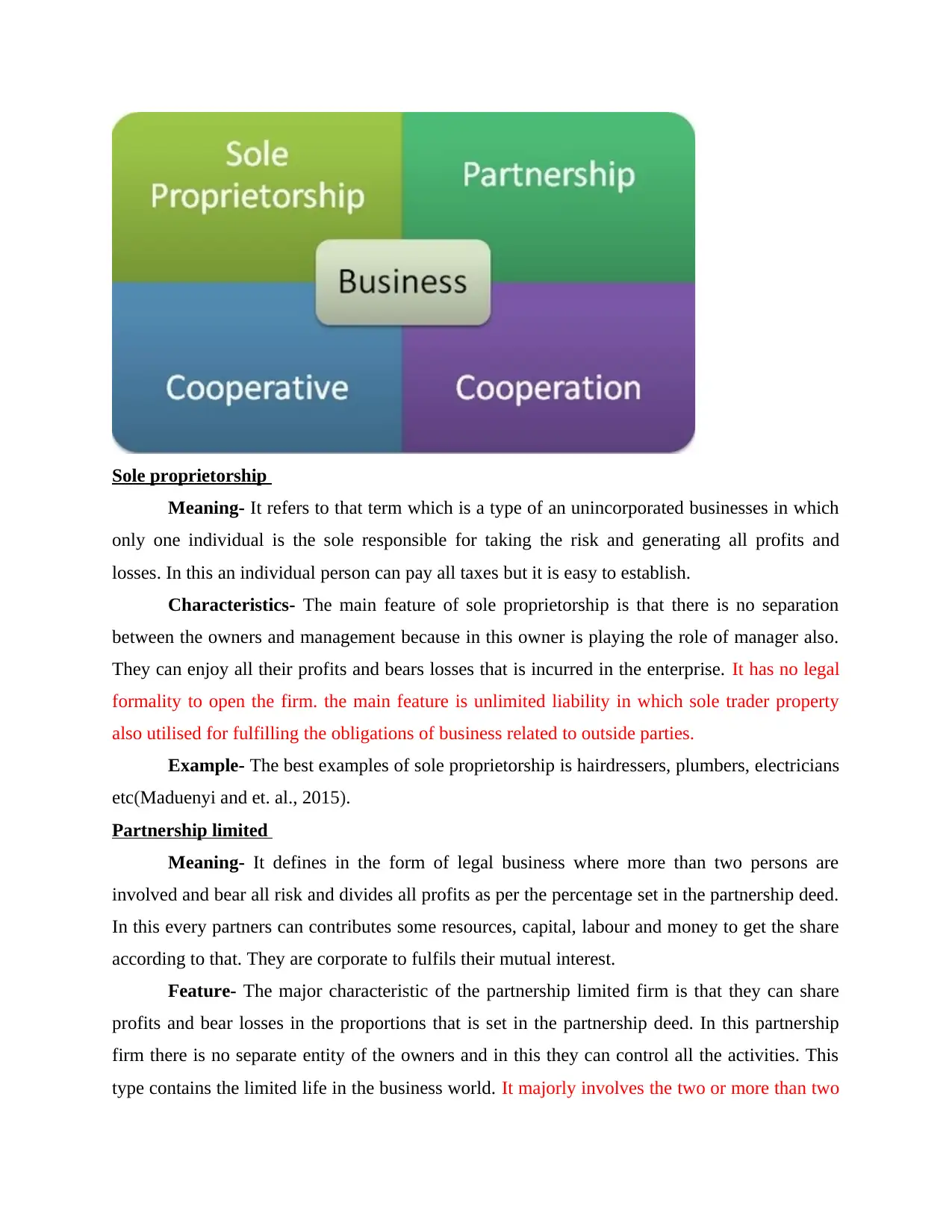
Sole proprietorship
Meaning- It refers to that term which is a type of an unincorporated businesses in which
only one individual is the sole responsible for taking the risk and generating all profits and
losses. In this an individual person can pay all taxes but it is easy to establish.
Characteristics- The main feature of sole proprietorship is that there is no separation
between the owners and management because in this owner is playing the role of manager also.
They can enjoy all their profits and bears losses that is incurred in the enterprise. It has no legal
formality to open the firm. the main feature is unlimited liability in which sole trader property
also utilised for fulfilling the obligations of business related to outside parties.
Example- The best examples of sole proprietorship is hairdressers, plumbers, electricians
etc(Maduenyi and et. al., 2015).
Partnership limited
Meaning- It defines in the form of legal business where more than two persons are
involved and bear all risk and divides all profits as per the percentage set in the partnership deed.
In this every partners can contributes some resources, capital, labour and money to get the share
according to that. They are corporate to fulfils their mutual interest.
Feature- The major characteristic of the partnership limited firm is that they can share
profits and bear losses in the proportions that is set in the partnership deed. In this partnership
firm there is no separate entity of the owners and in this they can control all the activities. This
type contains the limited life in the business world. It majorly involves the two or more than two
Meaning- It refers to that term which is a type of an unincorporated businesses in which
only one individual is the sole responsible for taking the risk and generating all profits and
losses. In this an individual person can pay all taxes but it is easy to establish.
Characteristics- The main feature of sole proprietorship is that there is no separation
between the owners and management because in this owner is playing the role of manager also.
They can enjoy all their profits and bears losses that is incurred in the enterprise. It has no legal
formality to open the firm. the main feature is unlimited liability in which sole trader property
also utilised for fulfilling the obligations of business related to outside parties.
Example- The best examples of sole proprietorship is hairdressers, plumbers, electricians
etc(Maduenyi and et. al., 2015).
Partnership limited
Meaning- It defines in the form of legal business where more than two persons are
involved and bear all risk and divides all profits as per the percentage set in the partnership deed.
In this every partners can contributes some resources, capital, labour and money to get the share
according to that. They are corporate to fulfils their mutual interest.
Feature- The major characteristic of the partnership limited firm is that they can share
profits and bear losses in the proportions that is set in the partnership deed. In this partnership
firm there is no separate entity of the owners and in this they can control all the activities. This
type contains the limited life in the business world. It majorly involves the two or more than two
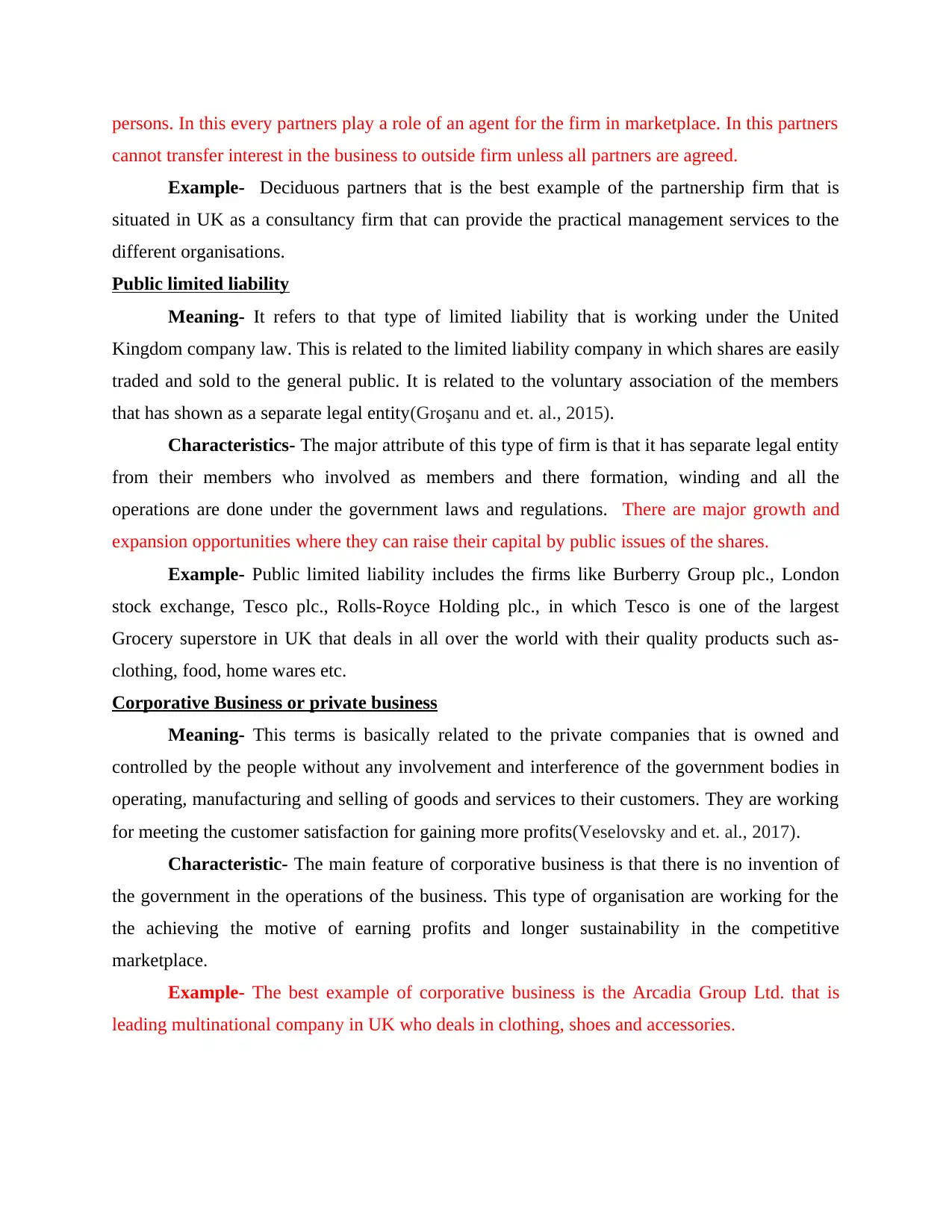
persons. In this every partners play a role of an agent for the firm in marketplace. In this partners
cannot transfer interest in the business to outside firm unless all partners are agreed.
Example- Deciduous partners that is the best example of the partnership firm that is
situated in UK as a consultancy firm that can provide the practical management services to the
different organisations.
Public limited liability
Meaning- It refers to that type of limited liability that is working under the United
Kingdom company law. This is related to the limited liability company in which shares are easily
traded and sold to the general public. It is related to the voluntary association of the members
that has shown as a separate legal entity(Groşanu and et. al., 2015).
Characteristics- The major attribute of this type of firm is that it has separate legal entity
from their members who involved as members and there formation, winding and all the
operations are done under the government laws and regulations. There are major growth and
expansion opportunities where they can raise their capital by public issues of the shares.
Example- Public limited liability includes the firms like Burberry Group plc., London
stock exchange, Tesco plc., Rolls-Royce Holding plc., in which Tesco is one of the largest
Grocery superstore in UK that deals in all over the world with their quality products such as-
clothing, food, home wares etc.
Corporative Business or private business
Meaning- This terms is basically related to the private companies that is owned and
controlled by the people without any involvement and interference of the government bodies in
operating, manufacturing and selling of goods and services to their customers. They are working
for meeting the customer satisfaction for gaining more profits(Veselovsky and et. al., 2017).
Characteristic- The main feature of corporative business is that there is no invention of
the government in the operations of the business. This type of organisation are working for the
the achieving the motive of earning profits and longer sustainability in the competitive
marketplace.
Example- The best example of corporative business is the Arcadia Group Ltd. that is
leading multinational company in UK who deals in clothing, shoes and accessories.
cannot transfer interest in the business to outside firm unless all partners are agreed.
Example- Deciduous partners that is the best example of the partnership firm that is
situated in UK as a consultancy firm that can provide the practical management services to the
different organisations.
Public limited liability
Meaning- It refers to that type of limited liability that is working under the United
Kingdom company law. This is related to the limited liability company in which shares are easily
traded and sold to the general public. It is related to the voluntary association of the members
that has shown as a separate legal entity(Groşanu and et. al., 2015).
Characteristics- The major attribute of this type of firm is that it has separate legal entity
from their members who involved as members and there formation, winding and all the
operations are done under the government laws and regulations. There are major growth and
expansion opportunities where they can raise their capital by public issues of the shares.
Example- Public limited liability includes the firms like Burberry Group plc., London
stock exchange, Tesco plc., Rolls-Royce Holding plc., in which Tesco is one of the largest
Grocery superstore in UK that deals in all over the world with their quality products such as-
clothing, food, home wares etc.
Corporative Business or private business
Meaning- This terms is basically related to the private companies that is owned and
controlled by the people without any involvement and interference of the government bodies in
operating, manufacturing and selling of goods and services to their customers. They are working
for meeting the customer satisfaction for gaining more profits(Veselovsky and et. al., 2017).
Characteristic- The main feature of corporative business is that there is no invention of
the government in the operations of the business. This type of organisation are working for the
the achieving the motive of earning profits and longer sustainability in the competitive
marketplace.
Example- The best example of corporative business is the Arcadia Group Ltd. that is
leading multinational company in UK who deals in clothing, shoes and accessories.
⊘ This is a preview!⊘
Do you want full access?
Subscribe today to unlock all pages.

Trusted by 1+ million students worldwide
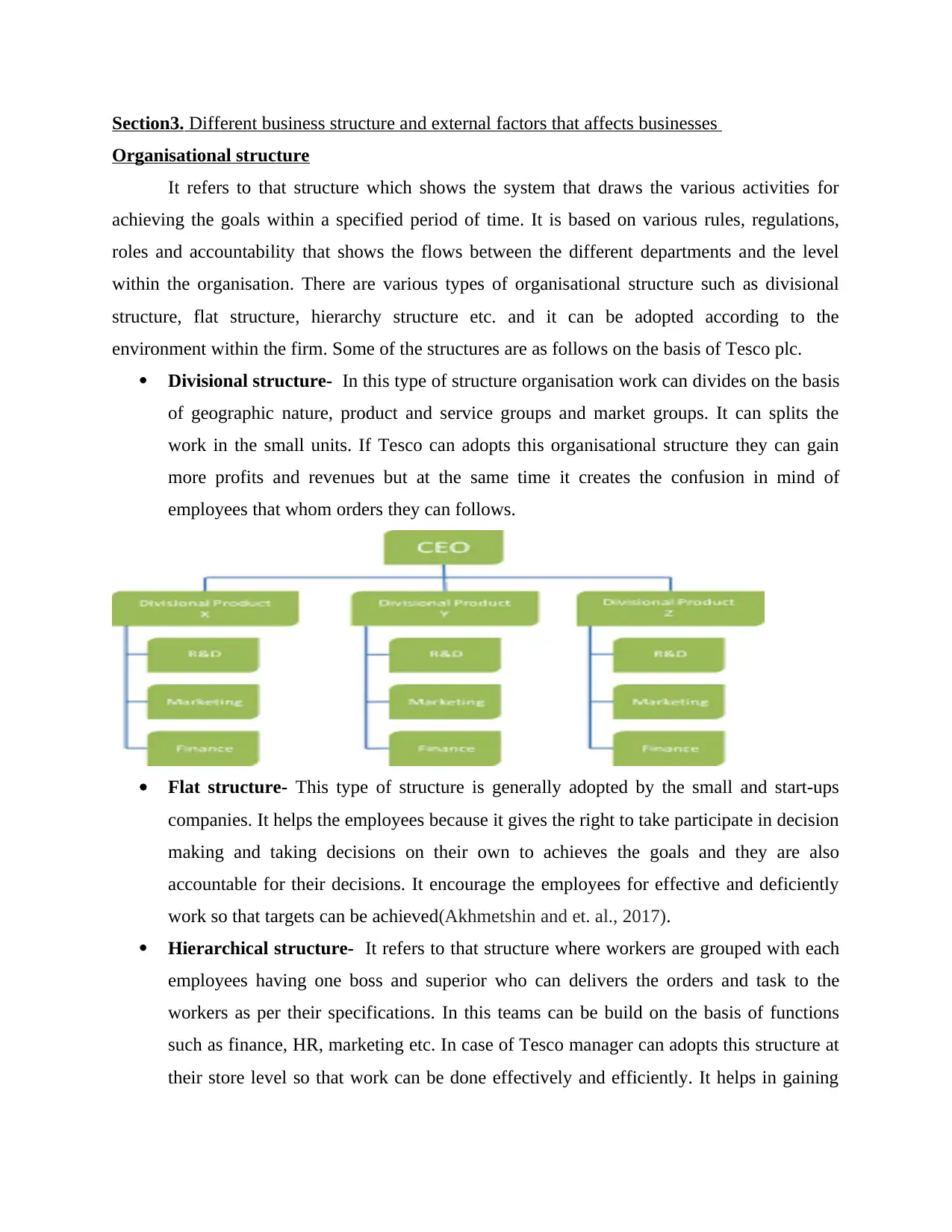
Section3. Different business structure and external factors that affects businesses
Organisational structure
It refers to that structure which shows the system that draws the various activities for
achieving the goals within a specified period of time. It is based on various rules, regulations,
roles and accountability that shows the flows between the different departments and the level
within the organisation. There are various types of organisational structure such as divisional
structure, flat structure, hierarchy structure etc. and it can be adopted according to the
environment within the firm. Some of the structures are as follows on the basis of Tesco plc.
Divisional structure- In this type of structure organisation work can divides on the basis
of geographic nature, product and service groups and market groups. It can splits the
work in the small units. If Tesco can adopts this organisational structure they can gain
more profits and revenues but at the same time it creates the confusion in mind of
employees that whom orders they can follows.
Flat structure- This type of structure is generally adopted by the small and start-ups
companies. It helps the employees because it gives the right to take participate in decision
making and taking decisions on their own to achieves the goals and they are also
accountable for their decisions. It encourage the employees for effective and deficiently
work so that targets can be achieved(Akhmetshin and et. al., 2017).
Hierarchical structure- It refers to that structure where workers are grouped with each
employees having one boss and superior who can delivers the orders and task to the
workers as per their specifications. In this teams can be build on the basis of functions
such as finance, HR, marketing etc. In case of Tesco manager can adopts this structure at
their store level so that work can be done effectively and efficiently. It helps in gaining
Organisational structure
It refers to that structure which shows the system that draws the various activities for
achieving the goals within a specified period of time. It is based on various rules, regulations,
roles and accountability that shows the flows between the different departments and the level
within the organisation. There are various types of organisational structure such as divisional
structure, flat structure, hierarchy structure etc. and it can be adopted according to the
environment within the firm. Some of the structures are as follows on the basis of Tesco plc.
Divisional structure- In this type of structure organisation work can divides on the basis
of geographic nature, product and service groups and market groups. It can splits the
work in the small units. If Tesco can adopts this organisational structure they can gain
more profits and revenues but at the same time it creates the confusion in mind of
employees that whom orders they can follows.
Flat structure- This type of structure is generally adopted by the small and start-ups
companies. It helps the employees because it gives the right to take participate in decision
making and taking decisions on their own to achieves the goals and they are also
accountable for their decisions. It encourage the employees for effective and deficiently
work so that targets can be achieved(Akhmetshin and et. al., 2017).
Hierarchical structure- It refers to that structure where workers are grouped with each
employees having one boss and superior who can delivers the orders and task to the
workers as per their specifications. In this teams can be build on the basis of functions
such as finance, HR, marketing etc. In case of Tesco manager can adopts this structure at
their store level so that work can be done effectively and efficiently. It helps in gaining
Paraphrase This Document
Need a fresh take? Get an instant paraphrase of this document with our AI Paraphraser
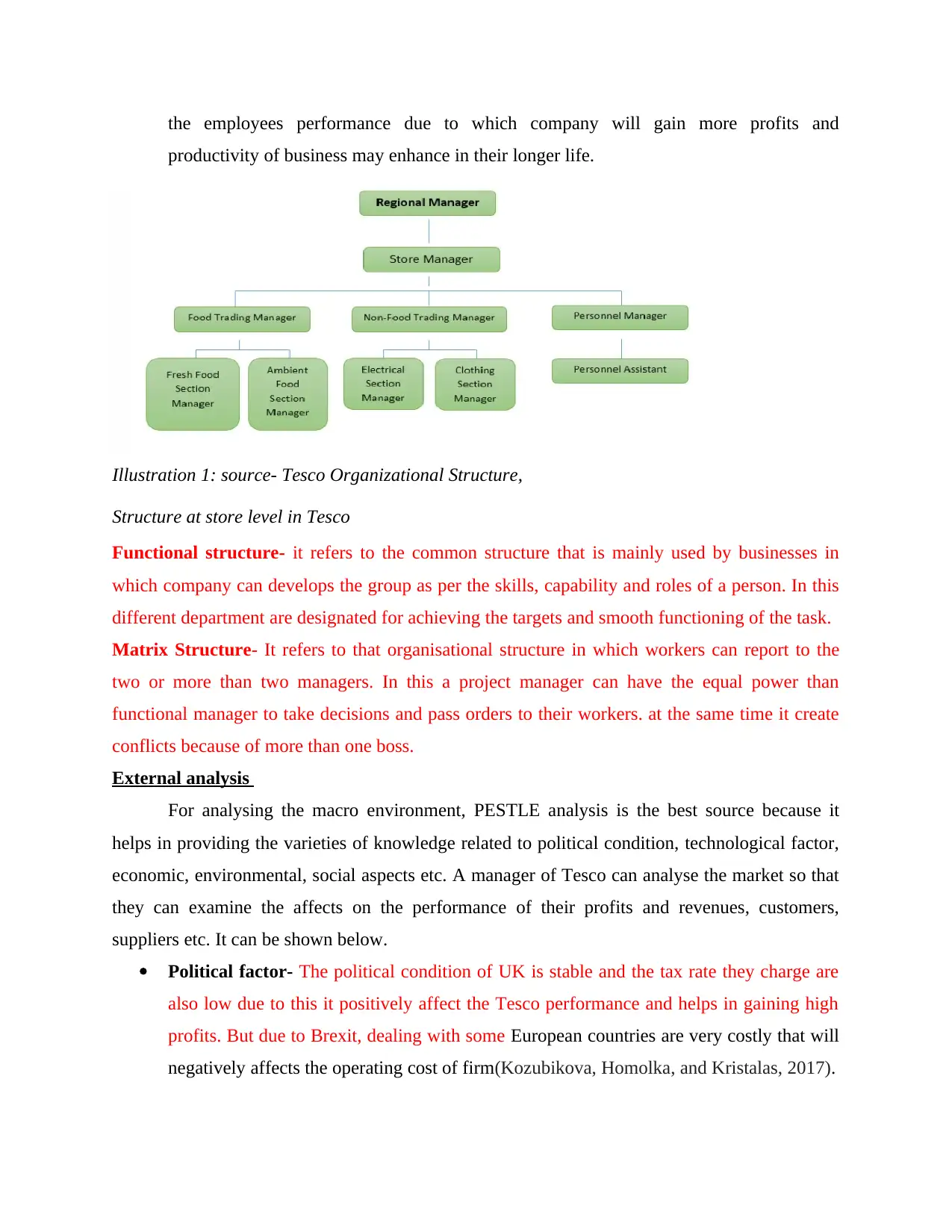
the employees performance due to which company will gain more profits and
productivity of business may enhance in their longer life.
Illustration 1: source- Tesco Organizational Structure,
Structure at store level in Tesco
Functional structure- it refers to the common structure that is mainly used by businesses in
which company can develops the group as per the skills, capability and roles of a person. In this
different department are designated for achieving the targets and smooth functioning of the task.
Matrix Structure- It refers to that organisational structure in which workers can report to the
two or more than two managers. In this a project manager can have the equal power than
functional manager to take decisions and pass orders to their workers. at the same time it create
conflicts because of more than one boss.
External analysis
For analysing the macro environment, PESTLE analysis is the best source because it
helps in providing the varieties of knowledge related to political condition, technological factor,
economic, environmental, social aspects etc. A manager of Tesco can analyse the market so that
they can examine the affects on the performance of their profits and revenues, customers,
suppliers etc. It can be shown below.
Political factor- The political condition of UK is stable and the tax rate they charge are
also low due to this it positively affect the Tesco performance and helps in gaining high
profits. But due to Brexit, dealing with some European countries are very costly that will
negatively affects the operating cost of firm(Kozubikova, Homolka, and Kristalas, 2017).
productivity of business may enhance in their longer life.
Illustration 1: source- Tesco Organizational Structure,
Structure at store level in Tesco
Functional structure- it refers to the common structure that is mainly used by businesses in
which company can develops the group as per the skills, capability and roles of a person. In this
different department are designated for achieving the targets and smooth functioning of the task.
Matrix Structure- It refers to that organisational structure in which workers can report to the
two or more than two managers. In this a project manager can have the equal power than
functional manager to take decisions and pass orders to their workers. at the same time it create
conflicts because of more than one boss.
External analysis
For analysing the macro environment, PESTLE analysis is the best source because it
helps in providing the varieties of knowledge related to political condition, technological factor,
economic, environmental, social aspects etc. A manager of Tesco can analyse the market so that
they can examine the affects on the performance of their profits and revenues, customers,
suppliers etc. It can be shown below.
Political factor- The political condition of UK is stable and the tax rate they charge are
also low due to this it positively affect the Tesco performance and helps in gaining high
profits. But due to Brexit, dealing with some European countries are very costly that will
negatively affects the operating cost of firm(Kozubikova, Homolka, and Kristalas, 2017).
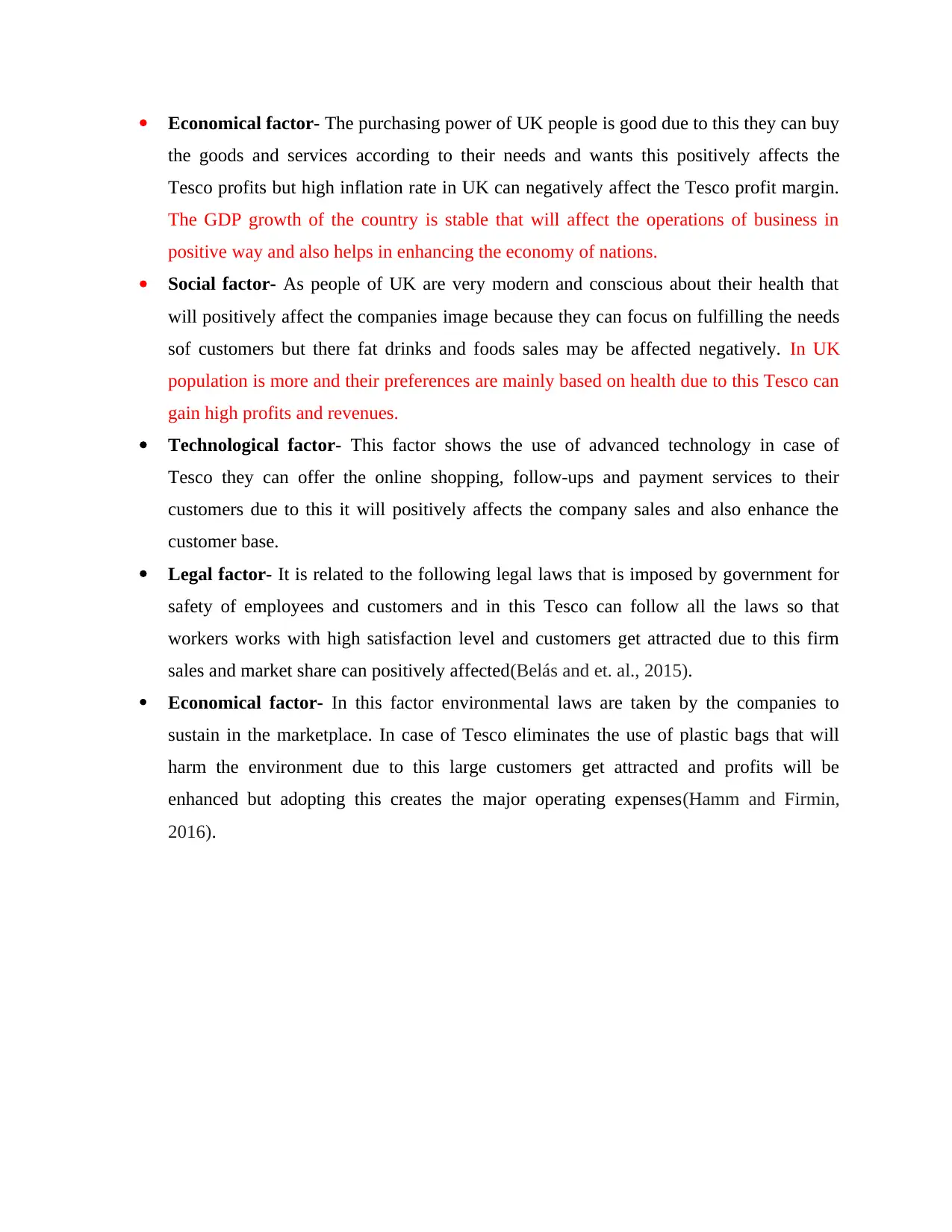
Economical factor- The purchasing power of UK people is good due to this they can buy
the goods and services according to their needs and wants this positively affects the
Tesco profits but high inflation rate in UK can negatively affect the Tesco profit margin.
The GDP growth of the country is stable that will affect the operations of business in
positive way and also helps in enhancing the economy of nations.
Social factor- As people of UK are very modern and conscious about their health that
will positively affect the companies image because they can focus on fulfilling the needs
sof customers but there fat drinks and foods sales may be affected negatively. In UK
population is more and their preferences are mainly based on health due to this Tesco can
gain high profits and revenues.
Technological factor- This factor shows the use of advanced technology in case of
Tesco they can offer the online shopping, follow-ups and payment services to their
customers due to this it will positively affects the company sales and also enhance the
customer base.
Legal factor- It is related to the following legal laws that is imposed by government for
safety of employees and customers and in this Tesco can follow all the laws so that
workers works with high satisfaction level and customers get attracted due to this firm
sales and market share can positively affected(Belás and et. al., 2015).
Economical factor- In this factor environmental laws are taken by the companies to
sustain in the marketplace. In case of Tesco eliminates the use of plastic bags that will
harm the environment due to this large customers get attracted and profits will be
enhanced but adopting this creates the major operating expenses(Hamm and Firmin,
2016).
the goods and services according to their needs and wants this positively affects the
Tesco profits but high inflation rate in UK can negatively affect the Tesco profit margin.
The GDP growth of the country is stable that will affect the operations of business in
positive way and also helps in enhancing the economy of nations.
Social factor- As people of UK are very modern and conscious about their health that
will positively affect the companies image because they can focus on fulfilling the needs
sof customers but there fat drinks and foods sales may be affected negatively. In UK
population is more and their preferences are mainly based on health due to this Tesco can
gain high profits and revenues.
Technological factor- This factor shows the use of advanced technology in case of
Tesco they can offer the online shopping, follow-ups and payment services to their
customers due to this it will positively affects the company sales and also enhance the
customer base.
Legal factor- It is related to the following legal laws that is imposed by government for
safety of employees and customers and in this Tesco can follow all the laws so that
workers works with high satisfaction level and customers get attracted due to this firm
sales and market share can positively affected(Belás and et. al., 2015).
Economical factor- In this factor environmental laws are taken by the companies to
sustain in the marketplace. In case of Tesco eliminates the use of plastic bags that will
harm the environment due to this large customers get attracted and profits will be
enhanced but adopting this creates the major operating expenses(Hamm and Firmin,
2016).
⊘ This is a preview!⊘
Do you want full access?
Subscribe today to unlock all pages.

Trusted by 1+ million students worldwide
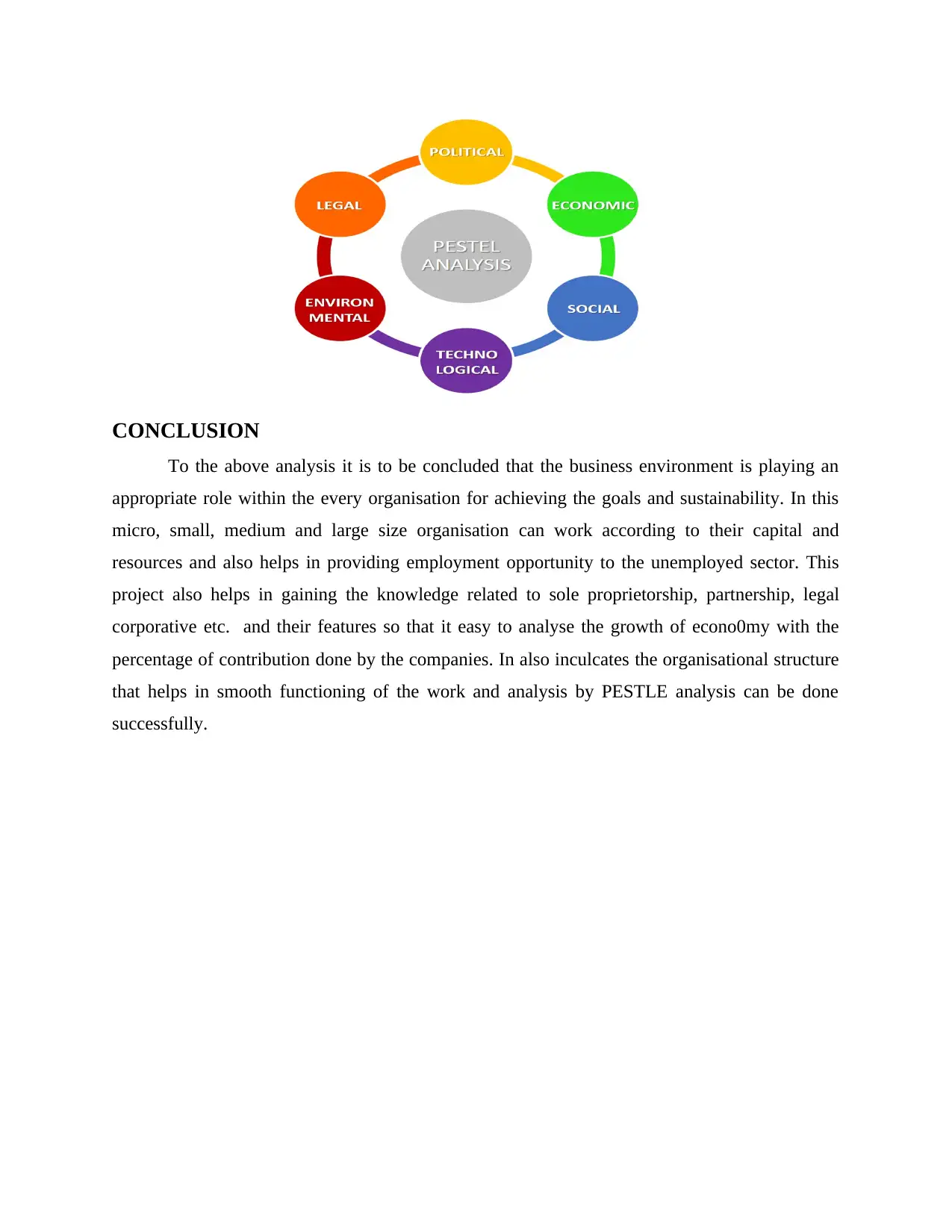
CONCLUSION
To the above analysis it is to be concluded that the business environment is playing an
appropriate role within the every organisation for achieving the goals and sustainability. In this
micro, small, medium and large size organisation can work according to their capital and
resources and also helps in providing employment opportunity to the unemployed sector. This
project also helps in gaining the knowledge related to sole proprietorship, partnership, legal
corporative etc. and their features so that it easy to analyse the growth of econo0my with the
percentage of contribution done by the companies. In also inculcates the organisational structure
that helps in smooth functioning of the work and analysis by PESTLE analysis can be done
successfully.
To the above analysis it is to be concluded that the business environment is playing an
appropriate role within the every organisation for achieving the goals and sustainability. In this
micro, small, medium and large size organisation can work according to their capital and
resources and also helps in providing employment opportunity to the unemployed sector. This
project also helps in gaining the knowledge related to sole proprietorship, partnership, legal
corporative etc. and their features so that it easy to analyse the growth of econo0my with the
percentage of contribution done by the companies. In also inculcates the organisational structure
that helps in smooth functioning of the work and analysis by PESTLE analysis can be done
successfully.
Paraphrase This Document
Need a fresh take? Get an instant paraphrase of this document with our AI Paraphraser
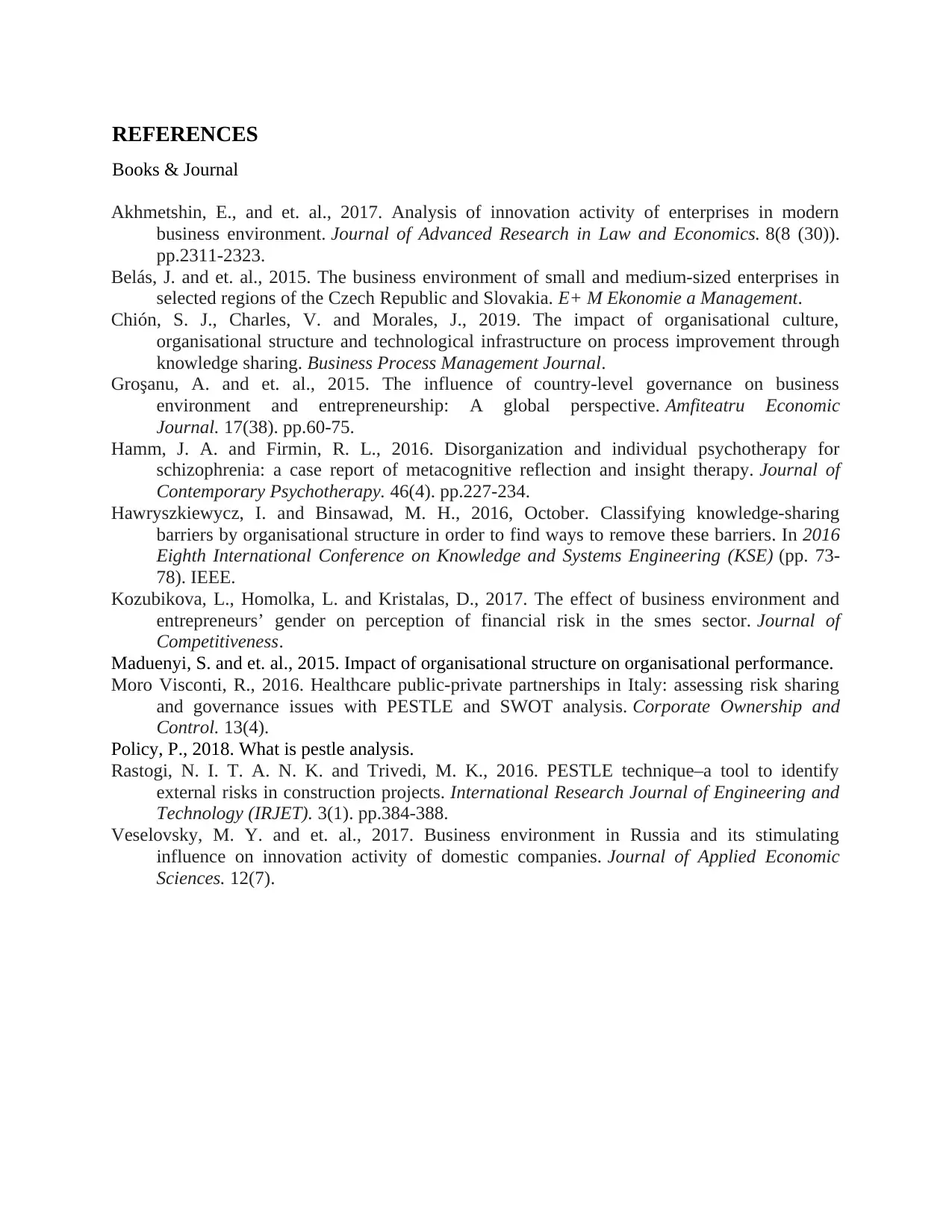
REFERENCES
Books & Journal
Akhmetshin, E., and et. al., 2017. Analysis of innovation activity of enterprises in modern
business environment. Journal of Advanced Research in Law and Economics. 8(8 (30)).
pp.2311-2323.
Belás, J. and et. al., 2015. The business environment of small and medium-sized enterprises in
selected regions of the Czech Republic and Slovakia. E+ M Ekonomie a Management.
Chión, S. J., Charles, V. and Morales, J., 2019. The impact of organisational culture,
organisational structure and technological infrastructure on process improvement through
knowledge sharing. Business Process Management Journal.
Groşanu, A. and et. al., 2015. The influence of country-level governance on business
environment and entrepreneurship: A global perspective. Amfiteatru Economic
Journal. 17(38). pp.60-75.
Hamm, J. A. and Firmin, R. L., 2016. Disorganization and individual psychotherapy for
schizophrenia: a case report of metacognitive reflection and insight therapy. Journal of
Contemporary Psychotherapy. 46(4). pp.227-234.
Hawryszkiewycz, I. and Binsawad, M. H., 2016, October. Classifying knowledge-sharing
barriers by organisational structure in order to find ways to remove these barriers. In 2016
Eighth International Conference on Knowledge and Systems Engineering (KSE) (pp. 73-
78). IEEE.
Kozubikova, L., Homolka, L. and Kristalas, D., 2017. The effect of business environment and
entrepreneurs’ gender on perception of financial risk in the smes sector. Journal of
Competitiveness.
Maduenyi, S. and et. al., 2015. Impact of organisational structure on organisational performance.
Moro Visconti, R., 2016. Healthcare public-private partnerships in Italy: assessing risk sharing
and governance issues with PESTLE and SWOT analysis. Corporate Ownership and
Control. 13(4).
Policy, P., 2018. What is pestle analysis.
Rastogi, N. I. T. A. N. K. and Trivedi, M. K., 2016. PESTLE technique–a tool to identify
external risks in construction projects. International Research Journal of Engineering and
Technology (IRJET). 3(1). pp.384-388.
Veselovsky, M. Y. and et. al., 2017. Business environment in Russia and its stimulating
influence on innovation activity of domestic companies. Journal of Applied Economic
Sciences. 12(7).
Books & Journal
Akhmetshin, E., and et. al., 2017. Analysis of innovation activity of enterprises in modern
business environment. Journal of Advanced Research in Law and Economics. 8(8 (30)).
pp.2311-2323.
Belás, J. and et. al., 2015. The business environment of small and medium-sized enterprises in
selected regions of the Czech Republic and Slovakia. E+ M Ekonomie a Management.
Chión, S. J., Charles, V. and Morales, J., 2019. The impact of organisational culture,
organisational structure and technological infrastructure on process improvement through
knowledge sharing. Business Process Management Journal.
Groşanu, A. and et. al., 2015. The influence of country-level governance on business
environment and entrepreneurship: A global perspective. Amfiteatru Economic
Journal. 17(38). pp.60-75.
Hamm, J. A. and Firmin, R. L., 2016. Disorganization and individual psychotherapy for
schizophrenia: a case report of metacognitive reflection and insight therapy. Journal of
Contemporary Psychotherapy. 46(4). pp.227-234.
Hawryszkiewycz, I. and Binsawad, M. H., 2016, October. Classifying knowledge-sharing
barriers by organisational structure in order to find ways to remove these barriers. In 2016
Eighth International Conference on Knowledge and Systems Engineering (KSE) (pp. 73-
78). IEEE.
Kozubikova, L., Homolka, L. and Kristalas, D., 2017. The effect of business environment and
entrepreneurs’ gender on perception of financial risk in the smes sector. Journal of
Competitiveness.
Maduenyi, S. and et. al., 2015. Impact of organisational structure on organisational performance.
Moro Visconti, R., 2016. Healthcare public-private partnerships in Italy: assessing risk sharing
and governance issues with PESTLE and SWOT analysis. Corporate Ownership and
Control. 13(4).
Policy, P., 2018. What is pestle analysis.
Rastogi, N. I. T. A. N. K. and Trivedi, M. K., 2016. PESTLE technique–a tool to identify
external risks in construction projects. International Research Journal of Engineering and
Technology (IRJET). 3(1). pp.384-388.
Veselovsky, M. Y. and et. al., 2017. Business environment in Russia and its stimulating
influence on innovation activity of domestic companies. Journal of Applied Economic
Sciences. 12(7).
1 out of 11
Related Documents
Your All-in-One AI-Powered Toolkit for Academic Success.
+13062052269
info@desklib.com
Available 24*7 on WhatsApp / Email
![[object Object]](/_next/static/media/star-bottom.7253800d.svg)
Unlock your academic potential
Copyright © 2020–2025 A2Z Services. All Rights Reserved. Developed and managed by ZUCOL.





